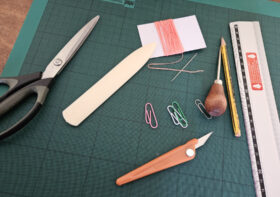Individual poems v collections – still on the learning curve

Putting together a collection of poems is proving to be harder than I ever expected. For a while now I’ve had a number of poems on a theme, which originally I dared to call ‘a pamphlet.’ I tried it on a few pamphlet comps: a couple of long-listings came of it, but basically nothing much.
So I looked very hard at the poems. Some were definitely stronger than others. Some I ditched entirely, some I took to workshops, some I worked on, and continue to do so. I sent them out as individual poems to a few places and it took a while but eventually a few of them have now been taken by magazines. But no-one has taken more than one, even though I’m now sending several as a ‘sequence’, or at least calling them ‘part of a sequence.’ I still believe very strongly in the sequence (or pamphlet, if that’s how it ends up) and perhaps I have more poems to write which may find their way in. But only a few of them ‘stand alone’ out of context. On the other hand, if I cut some poems and settle for a sequence, little else that I’ve written sits logically with it to make even a pamphlet. I feel like I have a lot of individual poems, but they have nothing in common with each other.
Showing groups of poems to various people in recent months has been difficult and nerve-wracking – feedback is mixed, and I feel knocked back, much more so than the feeling you get when a magazine submission is rejected, which I’m quite used to now. I’m very grateful for the feedback, especially if it’s offered as a favour, but asking someone to critique a collection of poems is very different from workshopping an individual poem. I find it impossible to link general comments to what’s not working in specific poems. I’ve also finally come to the conclusion that I struggle with written criticism, particularly if I’ve not actually met the person. You have no chance to interrogate the issue, get to the bottom of it – no dialogue, no chance to say ‘oh yes I see what you mean, so this doesn’t work because….if I do this, then…’ This has been an issue for me when I’ve taken part in online courses, for example.
I’ve thought for a long time what I need is a mentor, but as a poet friend pointed out to me recently, that may just be a cop-out. No-one has the magic answer to all this, or can tell me ‘what to do’ – or rather, they can, but is there ever ‘right’ advice? I need to work more on my writing, read more closely, and figure it out for myself.
I suppose I am learning though – for example, I’m learning which poems I feel strongly about, and which I can let go. Also, by looking endlessly at ways of ordering or re-ordering poems, and looking for possible links, I’ve actually identified a Key Poem – one which I used to think was nothing special, almost lightweight, fun in performance but no big deal. It’s a poem I’ve always struggled to explain to people but I can see now that it introduces overarching themes, and although it was OK as a standalone poem it can contribute more, has more to say, as part of a sequence.
I’m very interested to hear how others have tackled these kinds of issues, and any ideas of how to move forward, what’s worked for you. Do share, if you feel able to. Thanks.



Hi Robin – I got some great advice when I was putting my collection together: choose poems you’re prepared to stand over. And one I would add myself: choose the poems that you’ve invested most in, emotionally. Good luck with it!
Hi Afric, and thanks for commenting – yes, I think I’m learning that. I think I used to tell myself ‘oh this was published in such-and-such magazine, so it must be OK and I ought to include it’ rather than going with my own feeling about it. And what I write one year doesn’t always stand up three years later.
When Raymond Carver had enough poems for a collection his partner Tess Gallagher would lay them all out on the floor & gradually work out which poems spoke to, were in dialogue or contradiction to each other. That’s how they worked out the order of a collection. While I never tried that myself, I see which poems cluster round a set of themes I may not previously have been aware of, and that tends to order the ‘groups’ of poems that make up a collection for me. I then ask a favour of 5 or so trusted poet friends to give their views on whether or not the order works, which poems to ditch etc. Titles (either of the whole collection or seperate sections) might help with this process, but in my case it becomes quite organic & instinctive. Hope that helps
That’s very helpful, Rob, thanks so much. I like the sound of that process and will try to work through the poems in that way. I’m always a bit unsure of asking poet friends to help in this way but I suppose I can only ask, and be sure to return the favour in some way.
One issue to consider is whether you do or don’t want discrete sections to your collections, or want it to have a continuous ‘flow’ without them – it’s really considering what sort of shape you’re after. Poet friends can only say No, but it’s an unwritten rule you’ll return the favour if they want it!
Lots of things to consider, for sure! I guess the asking becomes easier as we all get to a similar stage in our writing and are starting to put collections together.
Hi Robin. All I can say is…persevere!
My first chapbook was rejected by two publishers before getting accepted by a third and I’m very glad it did, because after the rejections I edited, re-jigged, got rid of the “filler” poems to get it to a place where it all clicked. Corny I know.
I did find Pascale Petit’s “Working Towards a Collection” very useful, available from the Poetry School as a download, and if the poems aren’t quite gelling, have you considered splitting the collection into sections?
Just some thoughts but please don’t give up, it will be so worth it in the end! 🙂
Sorry Robin. I posted my comment before reading the previous ones!
I would definitely echo what Robert said about laying all the poems out on the floor to see who speaks to who, connections, what form compliments another, etc. (this is also an exercise in Pascale’s guide). I actually left my first and second collection poems on the floor in the front room over a few days to settle (husband not best pleased but tough!) and then that way you get a great overview of how your collection will look, read and feel.
Will stop now! All the best with it.
Thanks for the advice Julie, and don’t worry, I’m not giving up! I do the ‘laying out on floor’ thing – as you can see from the photo – it definitely shows up quite a few things one doesn’t see otherwise.
Hi Robin
This is a fascinating topic. I spent ages thinking about this for my collection. Sections is the way to go if you have a number of very different themes – quite fashionable now.
Always use the best bestest poems even if you think they don’t fit. Make the titles of yr sections quite large ie Episodes, Intimacies, etc so they will apply to loads and you don’t have to have the word in one of the poems for a section.
Interrogate your subconscious and think of the initial driver towards the poem/s.
I suddenly realised that most of my poems tho v different from each other seemed to be about transformation.
Also don’t forget you can cheat!! Your poems aren’t set in stone even if published so you can infiltrate ideas and words to make the theme link/s clearer. mxxxxxxxxx
Aha! good points, Marion, many thanks. Especially para 3, I’m only starting to think that way, I suppose it takes practice, like most things. Thanks again for commenting.
Hello Robin,
Well I definitely want to read your collection so please keep going.
I see that you’ve already had helpful comments. I also have used the laying out on the floor idea and then carried the resulting folder around so I could keep going back to it. As Rob suggests once you have an order for the poems it is invaluable to ask trusted poet friends or an editor to have a look as they will notice things that may not have occurred to you. They will come to the poems with fresh eyes and enthusiasm as I learned from working with Becky Cherriman on her first collection Empires of Clay (due from Cinnamon Press in November) .
Caroline